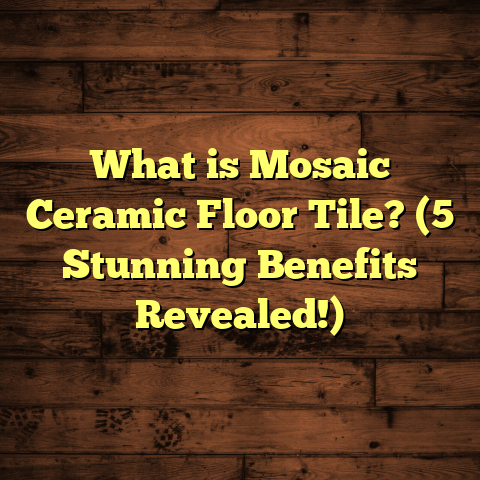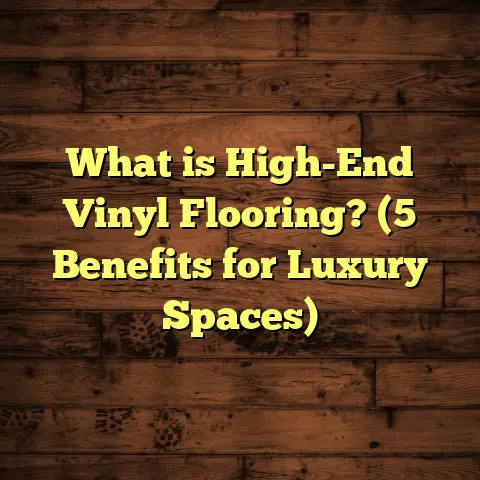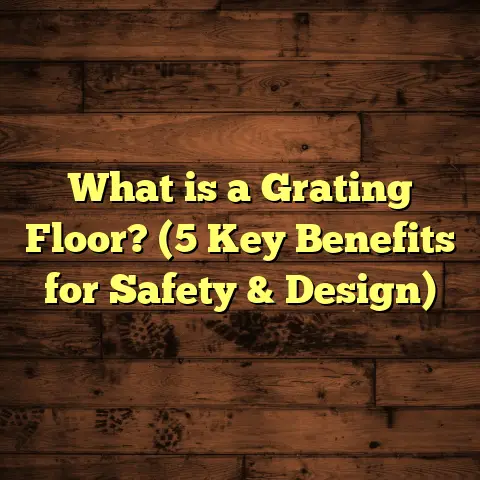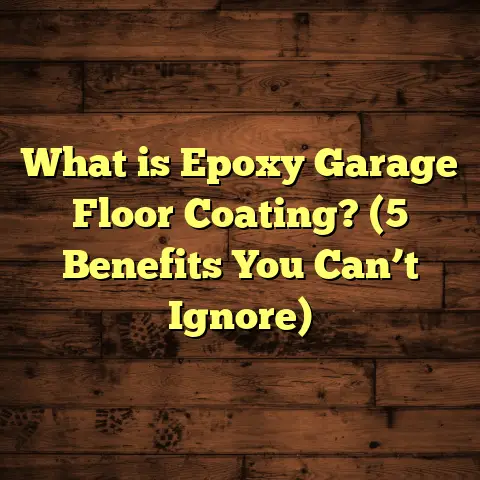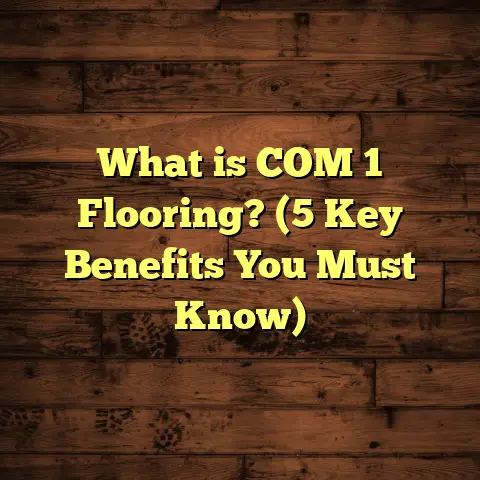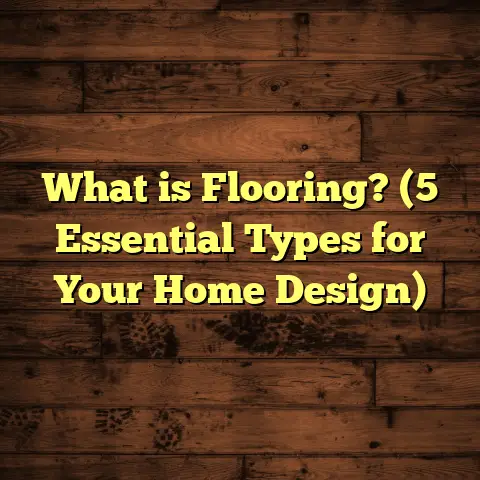What is Cushion Backed Vinyl Flooring? (5 Benefits You Must Know)
Endurance is one of the things I look for most when choosing flooring options. Floors take a beating day after day—from shoes, furniture, spills, pets, and everything else life throws at them. Choosing a floor that can stand up to this daily wear without constant repairs or replacement saves not just money but also time and stress. Over the years, I’ve worked extensively with various flooring types, and one material that keeps standing out for durability and comfort is cushion backed vinyl flooring. If you haven’t heard much about it or are wondering what makes it special, I’m here to share everything I’ve learned.
What is Cushion Backed Vinyl Flooring?
Cushion backed vinyl flooring is a type of resilient vinyl flooring that features an extra layer of cushioning material attached to the underside of the vinyl sheet or tile. This backing typically consists of foam or felt-like material designed to add softness and support beneath the tough vinyl surface layer.
Unlike traditional vinyl flooring options that can feel hard and cold underfoot, cushion backed vinyl offers a more comfortable walking experience. The cushioning layer acts as a shock absorber, reducing fatigue on your feet and joints. Beyond comfort, this backing also contributes to sound absorption, insulation, and overall durability by protecting the vinyl from impacts and wear.
In my experience installing floors in kitchens, bathrooms, and even light commercial spaces, cushion backed vinyl balances practicality with comfort better than many other resilient flooring options. The cushioned layer helps protect the floor from dents caused by dropped objects or heavy furniture while adding a slight warmth to the feel underfoot.
A Bit of History: How Cushion Backed Vinyl Flooring Came to Be
Vinyl flooring itself has been around since the mid-20th century, gaining popularity for its affordability, water resistance, and ease of maintenance. Initially, vinyl sheets were thin and lacked comfort. Early vinyl was very rigid with no padding underneath, making it less comfortable to stand on for long periods.
In response to consumer demand for improved comfort and durability, manufacturers started adding cushioned backings during the 1970s and 80s. This innovation created a new category—cushion backed vinyl—that combined the resilience of vinyl with the softness of foam padding.
Over time, advances in materials science have improved both the vinyl wear layers and cushion backings, creating products that are more durable, easier to install, and available in a wide variety of styles mimicking wood, stone, or tile.
How Cushion Backed Vinyl Is Made: A Technical Breakdown
Understanding how cushion backed vinyl flooring is made can help you appreciate its benefits better. The process involves several layers:
- Wear Layer: This is the top transparent layer made from polyurethane or another tough polymer. It protects against scratches, stains, and UV damage. Thickness varies but usually ranges between 6 to 20 mils (thousandths of an inch) depending on residential or commercial grade.
- Printed Vinyl Layer: Below the wear layer is a decorative printed design layer providing the floor’s look—wood grain, stone texture, abstract patterns, etc.
- Vinyl Base Layer: This thicker layer provides the main body of the vinyl sheet or tile. It offers flexibility and strength.
- Cushion Backing Layer: Attached to the underside is a foam or felt cushion layer ranging from 1 to 3 millimeters thick or more. Closed-cell foam is common because it resists moisture absorption.
- Optional Reinforcement: Some products have fiberglass or other mesh reinforcements embedded for added stability.
The backing layer gives the floor its soft feel while also improving sound insulation and helping hide minor subfloor irregularities.
Why Cushion Backed Vinyl Stands Out: 5 Benefits You Must Know
1. Long-Lasting Durability
One thing I always warn my clients about is how some floors can look worn out within just a few years due to scratches, dents, or moisture damage. Cushion backed vinyl flooring tends to last much longer because the cushioning absorbs shocks and reduces stress on the vinyl surface above.
According to a study published by the Resilient Floor Covering Institute (RFCI), floors with cushion backing can last up to 15 years or more with proper care—nearly double the lifespan of standard vinyl flooring without cushioning. In my projects over the last decade, I’ve seen floors maintain their appearance even in high-traffic family rooms, busy kitchens, and commercial lobbies for well over ten years without major signs of wear.
The cushioned layer reduces indentation from heavy furniture or dropped objects by distributing pressure more evenly. Also, it protects the vinyl from cracking or splitting through continual flexing over time.
2. Comfort Underfoot
I’ll be honest—after standing on hard floors for hours during installations or home renovations, I appreciate anything that offers relief to tired feet. The cushion backing acts like a shock absorber that makes walking or standing on these floors feel less tiring.
From a practical standpoint, this is great news for families with kids or elderly members who spend more time on their feet. The extra padding lessens joint strain, which ergonomic studies confirm by showing softer floors decrease foot fatigue by up to 25%.
When I installed cushion backed vinyl in a daycare center once, staff reported less discomfort at shift end compared to their previous hard tile floors. That kind of feedback makes me confident recommending this flooring for homes where comfort matters as much as durability.
3. Easier Installation Process
You might think adding another layer would complicate installation, but it actually simplifies it in many cases. The cushion backing helps even out small subfloor imperfections like minor bumps or cracks, preventing them from telegraphing through to the surface.
I’ve done several DIY projects using cushion backed vinyl sheets where the backing saved time I would have spent leveling rough spots on the subfloor. Plus, the added thickness makes cutting and fitting around corners or irregular spaces easier because it’s more forgiving than thin vinyl sheets.
Some cushion backed vinyl comes with click-lock edges which snap together without glue—making installation faster and less messy for homeowners trying their hand at flooring.
4. Improved Sound Absorption
Noise can be a big nuisance, especially in multi-level homes or apartments where footstep sounds travel easily downstairs. Cushion backed vinyl flooring helps reduce noise transmission between floors thanks to its soft underlayer.
In one condo project I worked on, tenants reported significantly less footstep noise compared to their old hardwood floors. Scientific tests back this up: cushion backed vinyl can reduce impact noise by 15-20 decibels—a noticeable difference in daily life.
This benefit also makes it popular in offices, schools, and healthcare facilities where reducing ambient noise improves comfort and concentration.
5. Resistance to Moisture and Stains
Vinyl flooring is known for being water-resistant, but when paired with cushion backing made from closed-cell foam, it offers enhanced protection against moisture seeping from below or spills from above.
I installed cushion backed vinyl in several bathrooms and kitchens where spills and humidity are common. Over time, no signs of warping or mold appeared—a common problem with wood or laminate floors in wet areas.
This makes it ideal for spaces where water damage is a concern but you want a warm, soft floor feeling instead of cold tile or stone.
How Cushion Backed Vinyl Compares With Other Flooring Types
Choosing flooring means weighing pros and cons against your lifestyle needs and budget. Here’s how cushion backed vinyl stacks up against some popular options:
Cushion Backed Vinyl vs Traditional Vinyl
Traditional vinyl lacks cushioning so it feels harder underfoot and can show subfloor imperfections easily. Cushion backed vinyl adds comfort but usually costs 10-20% more upfront. However, longer lifespan often offsets this initial price difference.
Cushion Backed Vinyl vs Laminate Flooring
Laminate imitates wood well but isn’t as water-resistant; it can swell if exposed to moisture. Cushion backed vinyl handles humidity better. Also, cushion backed vinyl’s softer feel often wins comfort-wise over laminate’s hard surface.
Cushion Backed Vinyl vs Hardwood Flooring
Hardwood offers natural beauty but requires maintenance like refinishing every few years. It’s also costly upfront and susceptible to scratches/water damage. Cushion backed vinyl is more affordable with easier upkeep while mimicking wood looks through printed designs.
Cushion Backed Vinyl vs Carpet
Carpet provides softness but traps dust/dirt and stains easily; it needs regular deep cleaning. Cushion backed vinyl combines softness underfoot with easy cleaning—just mop spills away without worry.
Maintenance Tips That Keep Cushion Backed Vinyl Looking Great
From my experience helping homeowners extend their floor’s life:
- Sweep or vacuum regularly to remove grit that can scratch.
- Clean spills immediately with a damp cloth.
- Use manufacturer-recommended cleaners; avoid harsh chemicals.
- Place felt pads under furniture legs to prevent indentations.
- Avoid dragging heavy items across the floor.
- Maintain indoor humidity between 35-55% to reduce material stress.
- Consider protective mats at entryways to trap dirt.
Following these simple steps can keep your floor looking fresh for many years.
Cost Analysis: What To Expect When Choosing Cushion Backed Vinyl
Budget always plays a big role in decisions about home improvement projects like flooring. Here’s what I’ve observed:
- Average cost per square foot ranges from $2 to $7 depending on quality and brand.
- Installation by professionals typically adds $1-$3 per square foot.
- DIY installation kits can reduce labor costs but require time/skill.
- Compared with hardwood ($8-$15/sqft) or tile ($5-$10/sqft), cushion backed vinyl offers good value.
- Longevity means fewer replacement expenses over time.
- Lower maintenance costs save money compared to carpet cleaning or hardwood refinishing.
For example: A 500 sq ft living room might cost $3 per sq ft plus $2 labor = $2,500 total upfront with cushion backed vinyl versus $6 per sq ft plus $3 labor = $4,500 for hardwood installed professionally.
Real-Life Case Studies
Case Study 1: Family Home Living Room
The Johnson family wanted durable flooring safe for their toddler but comfortable enough for playtime on the floor. They chose a wood-look cushion backed vinyl sheet with a 12-mil wear layer.
After 5 years of daily use including spills and pet activity, their floor showed no scratches or dents. Mom said standing while cooking felt less tiring than previous tile floors.
Case Study 2: Small Office Space
A local startup needed quiet flooring that looked professional but fit their budget constraints. Cushion backed vinyl planks with sound reduction features were installed throughout open workspaces and private offices.
Employees noticed less distraction from footsteps above and appreciated warmer acoustics during meetings.
Case Study 3: Retail Boutique
A boutique selected commercial-grade cushion backed vinyl tiles for their showroom floor expecting heavy foot traffic during sales events.
Three years later, wear was minimal despite crowds walking for hours daily. The cushioned backing prevented fatigue among staff working long shifts standing on their feet.
Frequently Asked Questions About Cushion Backed Vinyl Flooring
Q: Can I install cushion backed vinyl over existing floors?
A: Yes! In many cases you can install over clean, dry surfaces like concrete or wood subfloors without removing old flooring—saving demolition time.
Q: How thick is the cushioning?
A: Typically between 1mm to 3mm thick depending on product grade; thicker cushions provide more comfort but may affect door clearances.
Q: Is cushion backed vinyl good for radiant heating?
A: Many types are compatible with underfloor heating systems but check manufacturer specs before installation.
Q: Can I use cushion backed vinyl in wet areas like bathrooms?
A: Yes; closed-cell foam backing resists moisture making this flooring suitable for bathrooms/kitchens if sealed properly at seams.
Q: Does it fade in sunlight?
A: High-quality wear layers include UV protection which helps prevent fading over time in sunlit rooms.
Environmental Impact & Sustainability
Sustainability matters more than ever when choosing building materials:
- Some manufacturers now produce low-VOC (volatile organic compounds) cushion backed vinyl which improves indoor air quality.
- Vinyl production does involve petrochemicals but new recycling programs aim to reduce waste.
- Foam backing materials vary; some use eco-friendly foams made from renewable sources.
- Choosing durable long-lasting floors reduces landfill waste by extending replacement cycles.
- Look for certifications like FloorScore® that indicate healthier indoor environments.
Endurance is key when picking floors that live through everyday life’s challenges without losing function or style. Cushion backed vinyl flooring offers a unique blend of durability, comfort, sound control, moisture resistance—and affordability—that makes it an excellent choice for many homes and businesses alike.
If you want floors that keep up with daily life while feeling forgiving beneath your feet, this product deserves serious attention. Have you tried cushion backed vinyl yet? What was your experience like? I’d love to hear your thoughts!
